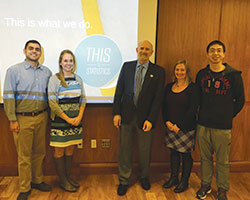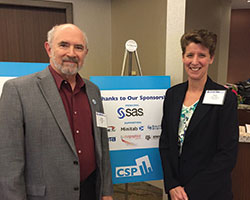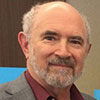ASA Leaders Reminisce: David Morganstein
In the 21st installment of the Amstat News series of interviews with ASA presidents and executive directors, we feature a discussion with 2015 ASA President David Morganstein.
Jim Cochran
David Morganstein is a vice president at Westat, Inc., where he has worked since 1976. He is the director of Westat’s statistical staff of 70 MS and PhD statisticians and survey methodologists. A senior statistician with more than 40 years of experience, his areas of expertise include the design and application of sample surveys and systems of evaluation, quality control, statistical analysis, and estimation and quantification.
Morganstein is a fellow of the American Statistical Association and was ASA president in 2015. Previously, he served on the ASA’s Board of Directors as treasurer and vice president. He is a recipient of the ASA’s Founders Award and an elected member of the International Statistics Institute (ISI). He chaired the ISI’s Ethics Committee when it revised the ISI Declaration on Professional Ethics and has served on the ISI Ethics Advisory Board.
Since its inception, Morganstein has instructed in the Joint Program in Survey Methodology, sponsored by the University of Maryland, and is currently a special faculty. He also serves on George Mason University’s Statistics Department Advisory Board. He has made numerous presentations on statistical issues and published papers in journals including Statistics and Public Policy, Journal of Official Statistics, Statistical Journal of the IAOS, Statistics in Medicine, Journal of the American Medical Association, and the Proceedings of the Joint Statistical Meetings.
Morganstein holds a BSEE in electrical engineering from Purdue University and an MA in statistics from the University of Michigan.
Q: In a December 2014 interview with Brigid Schulte of The Washington Post, you commented on reasons why statistics has been more successful than other Big Data STEM fields in attracting women. The ASA has actively worked through initiatives such as the This Is Statistics campaign to make middle- and high-school girls and minorities more aware of the opportunities a statistics career can offer. How effective do you think these efforts have been, and what other efforts can the ASA undertake to attract the best and brightest young people to our discipline?

David Morganstein stands with students who attended a talk he gave to the Boston Chapter of the ASA in 2015.
A: The ASA is off to a good start, Jim. Taking the step of committing to do this was an important beginning! We won’t have a real measure of success for a while, not until we see if the number of young people—especially young women—taking AP Statistics in high school or taking undergrad programs in statistics increases.
In Jessica Utts’ president’s address, she noted that some 200,000 high-school students took the AP Statistics exam in 2014. The ASA is increasing outreach to parents, students, teachers, and high-school counselors to encourage students to take statistics classes when they enter college or complete a statistics undergrad degree as their next educational step.
As you may recall, I talked with nine women who are very active in the ASA, asking them why they took up statistics as a career, in my August 2015 President’s Corner column. A common theme expressed by most was that women enjoyed collaborative work, wanted to make a positive impact on society, and wanted a career that could improve the lives of others. This is what we do!
Q: During your address at the 2015 Joint Statistical Meetings, you announced that the ASA would institute an annual mentoring award to be presented to a member who demonstrates extraordinary leadership in developing the careers of statistics students, statisticians, and statistical researchers. How are these efforts proceeding?
A: I am both proud and pleased that these activities continue. Several chapters and sections initiated mentoring programs in the past few years. We had another round of creating mentor/mentee pairs this year at both the Conference on Statistical Practice and the Joint Statistical Meetings. Importantly, we bestowed the first annual Outstanding Mentor Award at the Sunday night awards event.
The Awards Committee had some extraordinary nominees, and all the committee members felt a bit of awe at the task of making a choice. The stories told by the mentees were touching. There were so many superb nominees that the committee had to make two selections for this inaugural award: Doug Zahn and Fritz Scheuren.

Former ASA presidents David Morganstein and Sally Morton attend CSP 2016.
Q: You are a member of the advisory board for the George Mason University Statistics Department. What are your responsibilities in this role, and what have you learned about statistics education through this role?
A: Department Chair Bill Rosenberger assembled an advisory group from government and industry to provide feedback on GMU’s statistics program. Housed in the GMU Engineering School, the department serves a diverse and changing population in the Washington, DC, area. Bill seeks ideas for new directions and uses the group as a sounding board for important decisions he and the department face.
It’s probably fair to say that many statistics departments are in a struggle for support and funding from their college leadership. Not all deans, provosts, and other university leadership appreciate what our profession has to offer and how important a strong statistics department can be in attracting talented students and in giving them the tools they need to succeed when they graduate. With the reported need for workers specializing in data analysis in the next few years, departments like GMU’s are trying to recruit and train the next generation of statisticians.
Q: While serving as ASA president, you visited a number of chapters and universities. What message did you hear during those visits?
A: First, and very importantly, I saw firsthand the hard work of hundreds of volunteers in the chapters I visited. They were exceptional hosts and left me feeling like visiting dignitary! One clear and frequent message from them was, “How can I help?” The challenge for the ASA is finding ways to harness the energy and enthusiasm that’s out there.
Universities were always a great treat to visit. Talking with young, eager students is so uplifting! Sitting in a room with a few dozen and having them put challenging questions to me was both tough and fun. The ASA is seeing an increasing interest in forming student chapters, and a number are well underway. We have to think about how we can best support them while not getting in their way. A common request I heard from many students who were working in a new culture and a non-native language was for the ASA to help them improve their communication skills.
Q: You are chairing Barry Nussbaum’s initiative to collaborate with the ICSA, KISS, and IISA. What is that collaboration about, and what do you hope will come out of that effort?
A: We had our first meeting at JSM, and we’ve started email connections to discuss this, Jim. One objective is to help students make that transition to their first job wherever it may be. Related to that is the theme I mentioned about helping some improve communications skills. We started to discuss the topic of cultural differences. Are there things we should consider about the standards and norms that many from these associations are familiar with and whether they differ in a new and different culture? If so, can our associations provide training and seminars or publish articles with guidance that can help them identify and move beyond those differences? Another topic was finding ways of connecting their members to opportunities to get involved in ASA chapters and sections. I think there is a lot we can do to help with these issues!
Q: One of your initiatives made the connection with Stats.org. How has that effort evolved, and what might we see in the future?
A: Stats.org has come a long way since the ASA announced its partnership with Sense About Science USA. The website hits have grown to more than a million page views, according to Trevor Butterworth, editor of Stats.org. The website attracts many journalists. The number of case studies on the use and misuse of statistics in the news, public policies, and scientific research is growing. A couple of examples:
Christine Madsen talks about the importance of communication and mentorship in graduate student training, two themes of great importance to me.
Scott Harris argues that Founding Father George Washington was an early data scientist, because of his appreciation for gathering and using data that aided him throughout his life.
Stats.org and the ASA offer public engagement workshops for scientists and statistics workshops for journalists. Three of the former and five of the latter were held just this year alone. A public engagement workshop was held during the Women in Statistics and Data Science Conference in October. An advisory board offers free statistical help to journalists. In the 2016 Stats.org prospectus, ASA Executive Director Ron Wasserstein said, “The ASA-SAS USA partnership … has set its sights squarely on the target of developing a statistical literate citizenry, and is quite likely the most important development in the American Statistical Association’s long efforts to promote statistical literacy.”
Q: What are the big challenges facing the ASA and our profession?
A: One challenge is to stay involved in Big Data activity and the important use of statistics it makes possible. The ASA has done a number of things to connect with other professions, such as IT, that are also involved to tie this journey together.
Another truly difficult challenge is to make the point that good design and reliable data are needed to make sound decisions. We need to do this at a time when increasing numbers of people are viewing data as something one uses to prove a point and that often are cherry picked or not to be trusted. There’s a quip about using data the way a drunk uses a lamp post, more for support than illumination. We need to make a convincing argument that members of our profession can be trusted to summarize what our good designs and the reliable data we collect say, objectively and without bias.
Last, we need to expand our offerings for professional skills that help us all improve our ability to communicate and give us tools to lead. Our perspective is needed as much now as it ever has been. Our objectivity and appreciation for the assumptions and limitations of research are invaluable. We can work with and help journalists report events in an impartial and accurate way. This Is Statistics! This is what we do.











 (3 votes, average: 4.67 out of 5)
(3 votes, average: 4.67 out of 5)






